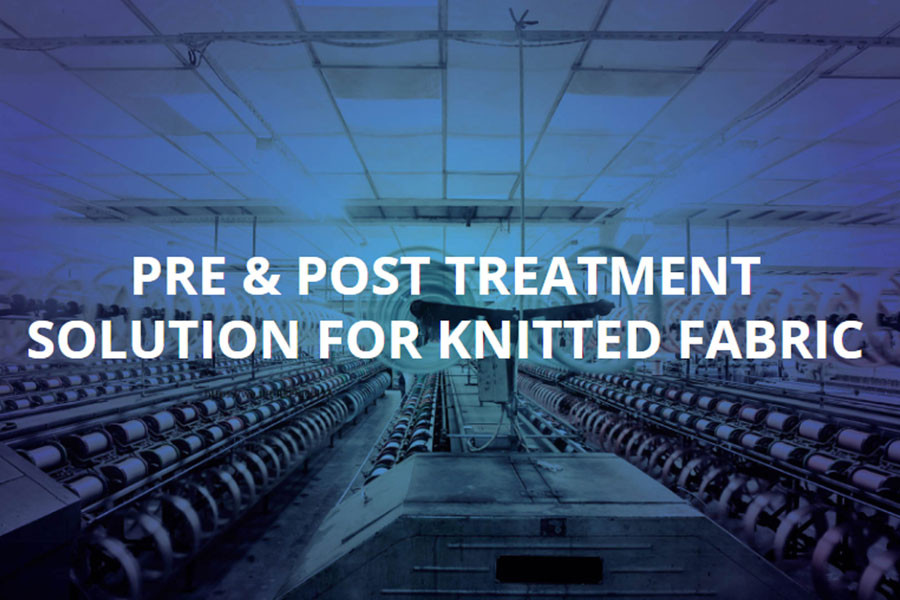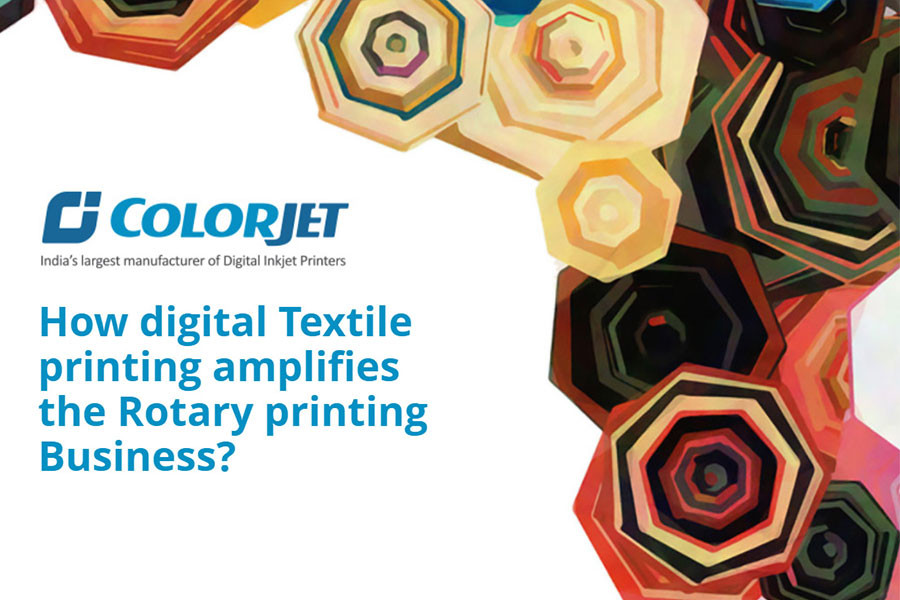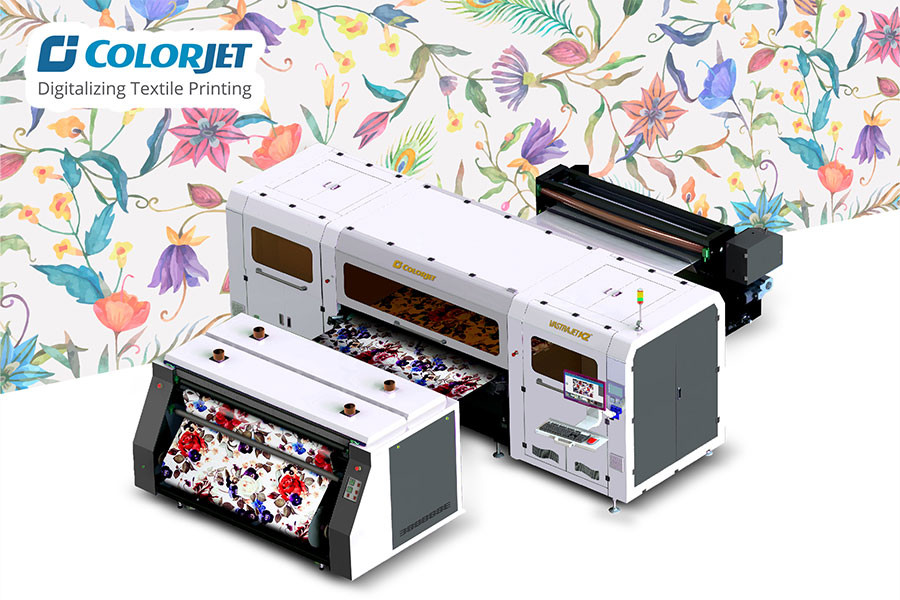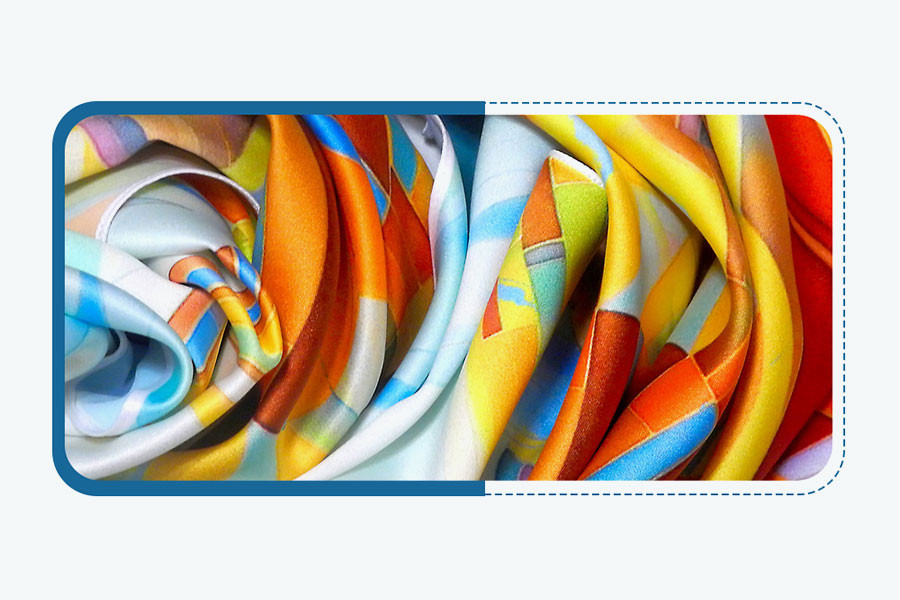
PRE & POST TREATMENT
SOLUTION FOR KNITTED FABRIC
Digital Textile Printing is on the rise due to its various benefits. It is apt to say that it is the future of Textile Printing. The textile market has seen growth at a fast pace. Trends like increasing purchasing power, population growth, are changing fashion trends are the key drivers for growth in the market of textile printing. Global printed textile production is expected to cross 36.8 billion sq. meters by 2024. As per projection, digital printing is expected to control around 10% of the total textile printing market. In simple words, digital textile printers use digital technologies just like your printers at home. This digital process has some similarities to conventional printing i.e. the RFD fabric needs to be pre treated before passing through the digital textile printer and subsequently steamed, washed and dried with the exception of pigment printing where pre & post treatment is optional. This is in contrast to the conventional screen printing method where the squeegee blade forces the dye paste evenly through the mesh on the screen across the width of the fabric. There are 3 processes involved pre-treatment, Printing, and post-treatment. Pre-treatment, which increases the wettability & settability of the RFD fabric, is a pre-requisite for Digital printing of knitted fabric and then there is post-treatment which is mainly done for fixation of the dyes and removal of unfixed dyes & auxiallary chemicals. In this article we are going to discuss the Pre and Post treatment solution for Knitted fabric

Pre -Treatment
Pre-treatment is a process that has many stages. The fabric needs to be RFD (ready for dyeing) before it gets digitally printed. In order to provide a high-quality output, ink needs to be properly absorbed on to the fabric.
Reactive, acid, and pigment inks are mostly used in Digital Textile Printing. In

Reactive/Acid ink, chemical bonds are formed between the ink and the fibre. Reactive ink is mostly used with cotton, linen, ramie, silk, and wool, whereas Acid ink is mostly used with Silk, wool, and nylon. In case of Pigment ink, as there is no affinity between the fibre & pigment it requires binder for fixation on the fibre & for polymerising the binder and forming a strong film curing(at high temp around 150 degree celsus) is required which goes in the sequence PRINT> DRY>CURE. The process of curing increases the color & wash fastness. Pigment ink is compatible with every fibre type.





Chemical padding increases the color penetration. The fabric goes through a padding mangle and a chemical is applied on the fabric. In case of both reactive and pigment printing, the common chemicals required for Knit fabric are Sodium Alginate, Soda Ash, Urea, Wetting Agent, Resist Salt, and Sodium Bicarbonate. Padding needs to be done uniformly and for best results, the paste should be stored 24 hrs before the padding. For most fabrics, a single dip and single squeeze is sufficient. For high gsm heavy fabric, double dip and double squeeze 3-bowl padding mangle is preferred. Generally, 3 drying chambers are recommended but 2 chambers can also give satisfactory results.
The choice of number of infrared heaters depends upon the scale of the production. The Weft Straightener makes sure of fibre alignment. Most of The knitted fabric is manufactured in tubular or cylindrical form and while processing it is cut open into a flat structure so the sides are prone to curl easily. In order to resolve the curling issue, a gumming unit is used, especially for the edges
Stenter
There are two types of stenter – Pin stenter and Clip stenter. For Knitted fabric, only pin stenter is used. Overall estimate of the Stenter from different companies ranges from $29882 approximately to over $2.7 Lakh approximately. Total connected load of 52 kW approximately is required for one chamber of 16 feet stenter. Total motive load requirement is 127 HP. Due to high power demand, gas heated stenters are preferred

Challenges and Solutions
One of the major problems in knitted fabric is bowing/skewing or in other words spirality. This happens when the wales and courses are not perpendicular to each other and printing in this stage can cause distortion of the design. In order to overcome this challenge, weft straightener and distortion detection as an attachment of stenter are used. To measure the scale of bowing and skewing, the modern stenter machine has some sensors too. Another challenge is knit fabric being cut open, especially single jersey, have a strong tendency to curve at selvedge. This undesirable curling creates problem in printing and bound to create bulky edges that tend to crease. The solution is a gumming unit as an attachment of stenter.
After the chamber, the fabric is rolled using a batching unit. This dry roll is now ready for print.

The pre-treated fabric, which is in the form of a roll, now goes for printing. Digital Inkjet Printers are used for Digital Textile Printing. The fabric gets digitally printed producing high-quality and vibrant output at high-speeds. Digital Textile Printing where small designs are printed on the garments is called DTG (Direct-to-Garment) printing. Large designs are also printed on large rolls of textile, which is generally used in Visual Communication, like corporate branding and advertising.


Post-treatment ensures better fixation of color, washing off of any harmful chemical, steaming of the fabric, removal of any crease, and makes the fabric wearable or useable. Post-treatment also involves number of stages like steaming, washing, etc.
Post-treatment of printed textile varies with different inks and every process takes different time. Refer to the graph below:


Printed dyes are usually fixed by the steaming process, where the steam provides the moisture and rapid heating that brings about the transfer of dye molecules from the thickener film to the fiber within a reasonable time. There is a steam generator

that provides adequate steam to the Ager machine that is being used. The steaming process offers a better color fastness. Post-treatment machines include Star Ager which is a Batch Process and Loop Ager which is a Continuous Process. Star Ager is generally used in small processing houses and is apt for sample printing. In Star Ager machine, steam is allowed to enter from the top of the chamber that drives out the air ensuring no assimilation of air and steam provides ideal environment for color fixation. It requires more manual labour and there are chances of uneven fixation of dye/color due to mis-handling. Every batch is kept inside for approximately 30 minutes. Loop Ager is used at big processing houses. They cost more but are more sustainable. Loop Ager machine typically consists of multiple sets of profiled hardened alloy steel rollers that induce a certain shape of the material. The Loop Ager machine cost ranges from $39390 approximately to $54331 approximately.


After the steaming process, the fabric is washed in the washing unit. Main aim of washing-off equipment is to remove thickening agent, unfixed dye/ink, and auxiliary chemicals. Most washing machinery line is continuous in operation, because of the amount of water, energy and labour costs involved in the batch-wise operation. There is Multi Chamber Washing Machine, which is a continuous process of washing.
These machines have fabric loading capacity of up to 900 Kgs. Some processing houses use the process of Manual Washing, which involves labour handling and is limited by length. The steam used in the steaming process is also used in the washing unit and calendar unit. The steam is used in the washing unit to heat up the water in order to avoid wastage of steam. The same steam is also introduced in the calendar unit through a pipe because the cylinder of this unit requires heating-up so that the fabric is ironed in a uniform manner.

Post-washing, the knitted fabric is dried in a drying unit. It can be done through a Hydro Extractor or a Tumble Dryer followed by calendaring . In Hydro Extractor Machines, the wet fabric is placed in the extractor with a wall of stainless steel; internal drum rotates at high-speed throwing out water in it. Hydro reduces the energy required to dry any material, it costs less ($461 approximately), and has limited capacity ranging from 10 to 20 Kgs. Tumble Dryer has higher efficiency, higher capacity (9 to 120 Kgs), and is high on cost ($25128 approximately).

The Pre and Post Treatment ensure a better color fixation and a high-quality output.



